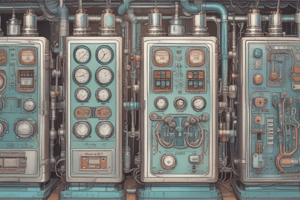Podcast
Questions and Answers
What does the term 'rebreathing' refer to in anesthetic systems?
What does the term 'rebreathing' refer to in anesthetic systems?
- Volume within the apparatus that may contain exhaled patient gas
- Recirculation of medical gases and vapors
- Rebreathing of some or all of the previously exhaled gases, including carbon dioxide and water vapor (correct)
- Delivery of medical gases and inhalational agents to the patient
What does the circuit refer to in breathing systems?
What does the circuit refer to in breathing systems?
- Apparatus that allows recirculation of medical gases and vapors (correct)
- Delivery of medical gases and inhalational agents to the patient
- Volume within the apparatus that may contain exhaled patient gas
- Rebreathing of previously exhaled gases
What is apparatus dead space in breathing systems?
What is apparatus dead space in breathing systems?
- Delivery of medical gases and inhalational agents to the patient
- Recirculation of medical gases and vapors
- Volume within the apparatus that may contain exhaled patient gas and which will be rebreathed at the beginning of a subsequent inspiratory breath (correct)
- Rebreathing of some or all of the previously exhaled gases, including carbon dioxide and water vapor
What is the term 'breathing system' used to describe?
What is the term 'breathing system' used to describe?
Which breathing system classification is commonly used in anesthesia today?
Which breathing system classification is commonly used in anesthesia today?
What is the function of an adjustable pressure limiting valve (APL) in a breathing system?
What is the function of an adjustable pressure limiting valve (APL) in a breathing system?
What is the purpose of a reservoir bag in a breathing system?
What is the purpose of a reservoir bag in a breathing system?
Which breathing system component is typically made of plastic but can be made of other materials?
Which breathing system component is typically made of plastic but can be made of other materials?
$f(x) = -4(x + 3)^2 + 2$. What is the vertex form of this quadratic function?
$f(x) = -4(x + 3)^2 + 2$. What is the vertex form of this quadratic function?
What is the primary function of an open breathing system?
What is the primary function of an open breathing system?
In which situations are Mapleson B and C systems used more frequently?
In which situations are Mapleson B and C systems used more frequently?
What are the characteristics of a simple and safe breathing system?
What are the characteristics of a simple and safe breathing system?
What do semi-closed and closed breathing systems do with gases?
What do semi-closed and closed breathing systems do with gases?
What are the classifications of Mapleson breathing systems?
What are the classifications of Mapleson breathing systems?
What length do breathing tubings vary depending on?
What length do breathing tubings vary depending on?
Which Mapleson system is most commonly used for controlled ventilation in anesthesia?
Which Mapleson system is most commonly used for controlled ventilation in anesthesia?
What is the primary limitation of the Magill (Mapleson A) system?
What is the primary limitation of the Magill (Mapleson A) system?
Which respiratory system is valveless and suitable for spontaneous ventilation in children up to 25-30 kg body weight?
Which respiratory system is valveless and suitable for spontaneous ventilation in children up to 25-30 kg body weight?
What distinguishes the Lack (Mapleson A) system from the Magill (Mapleson A) system?
What distinguishes the Lack (Mapleson A) system from the Magill (Mapleson A) system?
$f(x) = -4(x + 3)^2 + 2$. What does the value of $a$ represent in this equation?
$f(x) = -4(x + 3)^2 + 2$. What does the value of $a$ represent in this equation?
$g(x) = \frac{1},{x+2}$. What value of $x$ makes $g(x)$ undefined?
$g(x) = \frac{1},{x+2}$. What value of $x$ makes $g(x)$ undefined?
What is the primary advantage of Mapleson B and C systems over Mapleson A systems?
What is the primary advantage of Mapleson B and C systems over Mapleson A systems?
Which respiratory system has a coaxial tubing with a wide-diameter inside tube and outer tube to reduce resistance?
Which respiratory system has a coaxial tubing with a wide-diameter inside tube and outer tube to reduce resistance?
What distinguishes the T-piece system from other respiratory systems discussed in the text?
What distinguishes the T-piece system from other respiratory systems discussed in the text?
What makes the Lack (Mapleson A) system almost equally efficient for both spontaneous and controlled ventilation?
What makes the Lack (Mapleson A) system almost equally efficient for both spontaneous and controlled ventilation?
Flashcards are hidden until you start studying
Study Notes
- The text discusses various respiratory systems used in anesthesia, including the Magill (Mapleson A), Lack (Mapleson A), Mapleson B and C, Mapleson D (Bain), and T-piece (Mapleson E and F) systems.
- Magill (Mapleson A) system: Coaxial tubing (1.8 meters long), wide-diameter inside tube (14 mm), and outer tube (30 mm) to reduce resistance. Not suitable for children under 25-30 kg due to increased dead space.
- Lack (Mapleson A) system: Similar to the Magill system but with a shorter tube. Functionally almost equally efficient for spontaneous and controlled ventilation.
- Mapleson B and C systems: Similar in function to Mapleson A, but the fresh gas flow inlet is near the APL valve. Not commonly used due to the lack of advantage.
- Mapleson D (Bain) system: Coaxial system with a fresh gas inlet that minimizes mixing of fresh and exhaled gases. Most commonly used semi-closed circuit in anesthesia and suitable for controlled ventilation.
- T-piece system (Mapleson E and F): Valveless breathing system for children up to 25-30 kg body weight. Suitable for spontaneous ventilation but requires more fresh gas (2.5 times of minute ventilation). Does not have a breathing bag and is not a complete circuit.
Studying That Suits You
Use AI to generate personalized quizzes and flashcards to suit your learning preferences.




